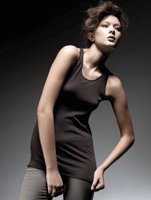Locally Grown
When it comes to production, some California companies find there’s no place like home.
Aaron AsheDesigner Ellie Spring of newcomer Aaron Ashe has been producing her label in California since its launch in Fall 2008. The line comprises solid-hued dresses, jumpers and feminine tops. All materials are sourced in California, including the eco-friendly silk used in many of the designs.
“The three main advantages of manufacturing in California versus overseas are product control, faster production and low minimums. Also, when you are starting out, California-based companies are more willing to work with lower minimums,” Spring says.
“Producing in California sometimes can give you a less competitive edge compared to those companies that produce overseas, but overall, the advantages outweigh the disadvantages,” she adds.
Aviator NationDesigner Paige Mycoskie translated her love for surfing and the California lifestyle into a comfortable, vintage-inspired collection of hoodies, tees and sweats that quickly caught the attention of trend-setting boutiques such as Fred Segal, Planet Blue, Blonde and Intuition. The line is sourced and produced entirely in California. Mycoskie also uses sewing machines from the ’60s and ’70s, ensuring that even the stitch work is done exactly as in years past.
“I get to personally check on my production daily, and the turnaround time is much quicker,” says Mycoskie, speaking about the benefits of producing in California.
She says the current state of the economy has in some ways been good for the company. “As a smaller company, it is sometimes difficult to find contractors and manufacturers to meet smaller minimums. But with the lack of work out there, contractors are more likely to work with smaller minimums. Also, it seems we are not competing nearly as much for the time and attention of the contractors anymore. Our work seems more valuable to them.”
Projected sales for the 1 frac12;-year-old label are $2 million for 2009.
Beth SpringerHandbag designer Beth Springer has produced her line in Southern California since the brand’s launch six years ago. She notes that most findings and fabrics used in the designs are sourced locally, and some are even custom-made in California. When she uses eco-friendly fabrics, she makes every effort to use local companies.
Springer echoes the sentiment of many California-based companies. “Better quality control is the biggest advantage [to California production], as well as shorter lead times,” she says.
Regarding the current economic climate, Springer says: “I have always wanted to be a 100 percent American-made brand. Thankfully, the Beth Springer brand is understood to be very high-quality with innovative design. As of yet, I have not changed the brand due to economic conditions. However, cost is a current factor in retail sales, so I am using innovations in the designs to attempt to decrease some of our cost without sacrificing luxury.”
California Rising With the name California Rising, it should come as no surprise that the brand has been produced in California since its launch in 2006. Comprising comfortable basics for men and women, the line will also launch a baby collection soon.
Husband-and-wife team Joshua Lloyd Fischer and Jules Blaine Davis take pride in the fact that all production is done in Los Angeles. Most of their eco-friendly fabrics are sourced locally, some from Enviro Textiles in Los Angeles, and some fibers are grown in California’s Central Valley. Partnering with SG Knits in Los Angeles, California Rising has also produced specialty fabrics.
Producing in California, Davis says, gives them “a smaller footprint and better control.”
“We like to support the California economy and use less oil to move products,” she says. “Moreover, the community is stronger when resources are kept close.”
Though Fischer and Davis admit it is more expensive to produce locally and “you must work harder to achieve certain qualities that are historically better in areas like Japan or Italy,” they are dedicated to producing with a conscience while also making items affordable.
“We are not willing to compromise our ethics and relationships by going overseas unless we absolutely need to and are very comfortable with those sources,” Davis says.
The company projects sales of $1 million wholesale and $1.5 million in online retail for 2009.
Edie-FranceNicole Magnifico-Parker of the label Edie-France says her entire line is produced in California, even down to the novelty belts added to the collection this holiday season.
Produced in Orange County, Calif., and downtown Los Angeles, Edie-France employs many fabrics, trims and embroideries sourced from California. The label has also entered the eco market: “We love our [prepared-for-dye] organic baby jersey we get from Neman Bros. downtown,” Magnifico-Parker raves. “We also dye it with organic dyes.”
Magnifico-Parker has worked for large and small companies and seen both sides of production. “The advantage of local production is definitely time,” she says. “You can catch mistakes a lot faster and/or make last-minute decisions much quicker, avoiding headaches. Plus, time equals money. People also love to see that merchandise is made in the USA.”
Minimums and pricing are Edie-France’s challenges “since everything has gone overseas,” Magnifico-Parker says.
But the down economy does have its silver lining, she notes. “Production has been better since a bunch of our competitors have probably gone out of business, and we are finding more houses that will have time now to do our production. Plus, their pricing has gone down.”
(213) 622-9160
Enza Costa Rogue Los Angeles brand Enza Costa Rogue, a division of J Brand, launched for Spring 2008. Stocked at Ron Herman, Tracey Ross and Wendy Foster, among other shops, the minimalist collection attempts to “blur the boundaries between casual and designer womenswear.”
Designer Enza Costa uses California resources whenever possible to produce the label, including yarns from California’s Central Valley. Some cashmere and silk yarns are imported from Italy, but they are knit and produced in Los Angeles. And all cutting, sewing, dyeing and finishing is done locally, primarily using independent contractors.
While it’s more expensive to produce domestically than overseas, Costa says: “[There’s] quicker turnaround and faster delivery dates. We can react when something does well for reorders. By being close to the facilities, we can better watch the quality of our garments.”
(213) 749-3500
Heather HawkinsDesigner Heather Hawkins crafts her line of stylish satchels from Italian leather, but she keeps production strictly local. The line has been produced by an independent contractor in downtown Los Angeles since its launch in 2004.
Hawkins chose Los Angeles because she has “better control over production” and does not have to worry about delays in customs.
While Hawkins says it is much cheaper to produce overseas, benefits include the ability to order smaller quantities and check the quality of materials before producing goods. “Also, production times are much, much shorter,” she notes. “Instead of waiting three to four months for your merchandise to arrive by boat, you can get most orders produced within about four to six weeks, sometimes faster, if necessary.
“Quality control is also easier to do here because everything can be checked one item at a time, and if there are mistakes, they can be fixed locally.”
Heather Hawkins sales are $300,000 annually.
Kate McHaleLaunched for Fall 2008, women’s pants line Kate McHale is 100 percent California-made by an off-site contractor in Los Angeles. All materials for the collection are sourced locally, as well.
Melding the best attributes of premium jeans—fit, comfort and attention to detail—with the sophistication and style of a beautiful trouser, McHale has set out to bridge the gap between denim and slacks.
McHale says she is committed to producing locally because it allows her to be “more hands-on with the entire process of creating the line.” Cost is a factor, she says, “but it doesn’t outweigh the quality available [by producing locally].
“The economy has affected the entire market,” she says. “But our customer wants fit and quality, and that’s what we deliver. Our product is designed and produced to stand the test of time.”
Projected sales for the first year are $1.6 million.
Revolver Los Angeles Since launching Revolver Los Angeles in 2003, Steven Vigil has produced his line in California via an off-site contractor. Furthermore, 90 percent of the fabric is produced locally. The small percentage that is not usually comprises specialty groups such as findings and trimmings. Most fabric purchased from California suppliers is also eco-friendly.
“The biggest advantage [to producing in California} is being able to create new styles very quickly,” Vigil says. “Sometimes I finish 75 percent of a collection the week of market. There would be no way to do this if I produced out of California.”
Vigil says there are huge advantages to producing locally when the economy is slow. “Stores are working much closer to deliveries, and being able to respond quickly has really helped our business,” he says. “I also don’t have to commit to inventory, so I have much less risk.”
Projected sales for 2009 are $2.8 million.
Stella & JamieDesigner April Mun has been producing her label, Stella & Jamie, in California since she launched the brand in Spring 2007. With the exception of cashmere sweaters, which make up a very small portion of the line for the Fall/Holiday season, all goods are produced in California. Almost all knits are from California, and many eco-friendly cottons are sourced in-state, as well.
Mun says she is proud to be helping the U.S. economy by using local resources, and cites fast turnaround and better quality control as distinct advantages of domestic production.
“Customers usually write their orders at once per season, but, nowadays, a lot of them are scared to write three to five months in advance,” Mun says. All customers want the products next month because we cannot predict what will happen in three months. But it actually benefits us a little bit because we can turn around the production faster for their needs.”
Stella & Jamie sales are $4 million annually.
























